GIGABYTE GB-BSi7HAL-6500 Dual LAN Skylake BRIX Review
by Ganesh T S on September 21, 2016 8:00 AM ESTPower Consumption and Thermal Characteristics
The power consumption at the wall was measured with a 1080p display being driven through the HDMI port. In the graphs below, we compare the idle and load power of the GIGABYTE GB-BSi7HAL-6500 with other low power PCs evaluated before. For load power consumption, we ran the AIDA64 System Stability Test with various stress components, as well as our custom stress test with Prime 95 and Furmark together, and noted the maximum sustained power consumption at the wall.
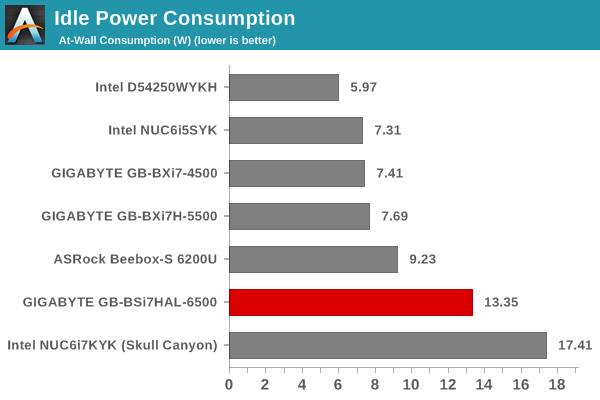
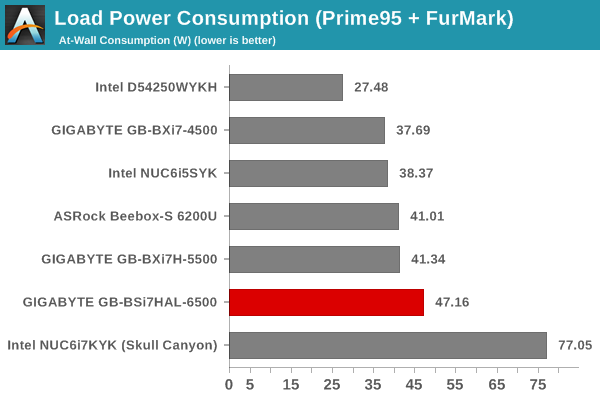
The GB-BSi7HAL-6500's power numbers are as per expectations, given the high-performance CPU and the configuration of the system with a PCIe 3.0 x4 NVMe SSD.
Our thermal stress routine starts with the system at idle, followed by four stages of different system loading profiles using the AIDA64 System Stability Test (each of 30 minutes duration). In the first stage, we stress the CPU, caches and RAM. In the second stage, we add the GPU to the above list. In the third stage, we stress the GPU standalone. In the final stage, we stress all the system components (including the disks). Beyond this, we leave the unit idle in order to determine how quickly the various temperatures in the system can come back to normal idling range. The various clocks, temperatures and power consumption numbers for the system during the above routine are presented in the graphs below. The temperature graph also shows the fan speed.
We also repeated the tests with our custom routine that loads up Prime 95 for 30 minutes, followed by Furmark for 30 minutes. The Prime 95 load is then removed, allowing just the GPU alone to be stressed for 30 minutes. The system is then left idle.
According to the official specifications, the junction temperature of the Core i7-6500U is 100C. The package temperatures are kept well below that in the AIDA64 system stability test, though our custom routine with both Prime95 and Furmark makes the package reach as much as 98C. However, there is no thermal throttling (just a slight dip in the package power consumption) as the core frequencies stay above the rate speed (2.5 GHz). The fan inside the chassis operates at 3000 RPM at default, and seems to be able to operate at either 6000 RPM when the system is heavily loaded, or, at 4000 RPM under moderate stress.


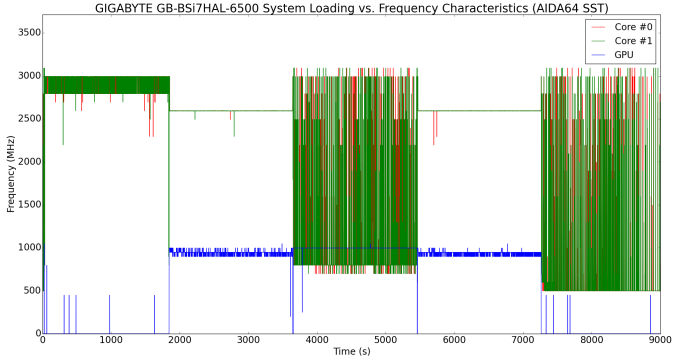
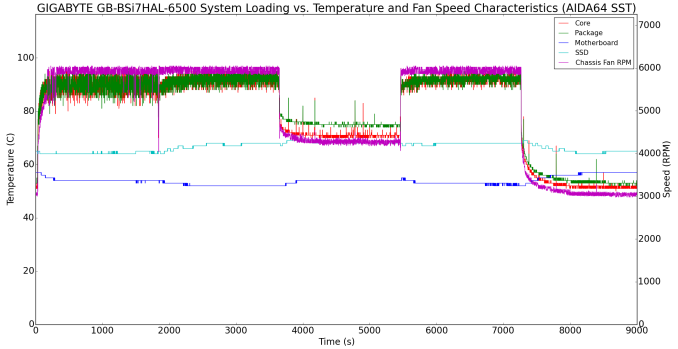
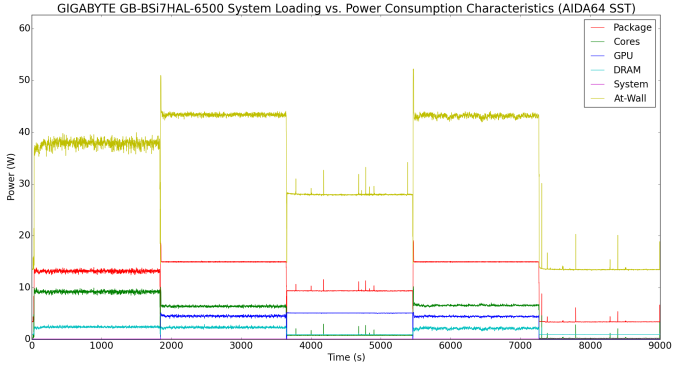
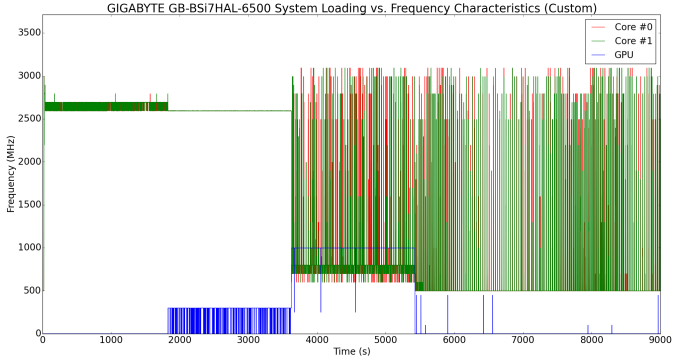
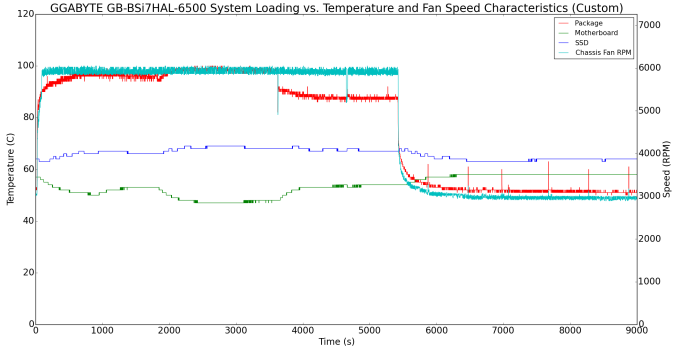









25 Comments
View All Comments
cknobman - Wednesday, September 21, 2016 - link
The price on these platforms is downright ridiculous.I know small has its price but at this point it just seems like Intel is profiteering.
powerarmour - Wednesday, September 21, 2016 - link
That price is an utter joke.ddriver - Wednesday, September 21, 2016 - link
More like mockery.nagi603 - Thursday, September 22, 2016 - link
Yeah, for the same price, (well, actually quite less, but with "only" 16GB ram and a 256GB SSD) I put together a mini-ITX box with a proper desktop-class i7.... And thanks to the bigger size, it is quite silent.JoeyJoJo123 - Wednesday, September 21, 2016 - link
You know, I actually got rather excited when I saw it'd be a dual LAN mini PC on Skylake, as this would work out very well for a pfSense router-box.>$591.
>$1030 as configured.
No thanks... Might be better to stick with one of those cheap chinese dual lan mini-PCs instead...
barleyguy - Thursday, September 22, 2016 - link
The Zotac ZBox EN760 has GTX 960 graphics as well as the dual lan ports, and could easily be configured comparably to this. That probably falls in your "cheap Chinese mini PCs" category, though I think Zotac is Tawainese.It's possibly on a lower quality tier than the Intel NUC or Gigabyte Brix. That said, I have the older version of it (EN860) and it works great as an HTPC box.
I have actually considered the Intel NUC for use with Thunderbolt pro audio. If you're pairing it up with thousands of dollars of studio gear the price seems less egregious. But if the Thunderbolt port is going to go unused, there's really no reason to choose that direction.
JoeyJoJo123 - Thursday, September 22, 2016 - link
The discrete graphics adds additional heat and cost that isn't useful for a pfSense box. It essentially acts as a server/router, using one LAN port as a WAN directly from a modem, then routes packets out accordingly from the other LAN port(s).Many Chinese fanless versions exist, but they use anemic celerons and atom CPUs. When you start using many extra features of pfSense, like squid (as a webproxy) the router's maximum throughput drops. Now this isn't an issue unless you have some kind of insane symmetrical 1gpbs up/down connection, where processor would fail to saturate the entire pipe.
I'd prefer to not have to worry, so I'd be all in for a fanless Mini-STX case and socketing in my own 6300T or something, but there are no fanless Mini-STX cases, and no Mini-STX motherboards with dual LAN. There are fanless thin Mini-ITX cases from Akasa, but I wasn't able to source a cheapish i3 + thin Mini-ITX mobo with dual LAN.
fanofanand - Wednesday, September 21, 2016 - link
$1030 using an iGPU. Pass.fanofanand - Wednesday, September 21, 2016 - link
Had to post a second comment, comparing this to the Skull Canyon, which has a better GPU/CPU, better wi-fi, and a better SSD really hurts the Brix. $3 less for nearly every component being better except 16 GB of RAM vs 32 GB. What use case does this box have where 32 GB of RAM becomes a factor? Are people running dozens of VMs off a box like this? I don't know about profiteering, but I don't see them selling many of these.kmmatney - Wednesday, September 21, 2016 - link
I can't see running too many VMs. The i7-6500U performs worse than an i3-6100 (uses a lot less power, but still...). I know going into these reviews that the prices will shock me, yet I'm still shocked when I see them.